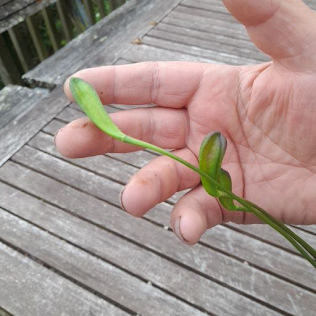The boiled green seed pods of Erythronium revolutum taste a lot like beans or peas, very good. They are also of good consistency, like beans or cucumber, and are a respectable size. It seems a little strange to me they are not more popular as a vegetable.
I could only find one reference to these pods being edible (1) which says the pods of Erythronium species in general were "said" to taste of string beans once cooked. They do list this species specifically amongst others but other than this recent book there only seem to be two older written references to Erythronium pods being eaten, specifically those of Erythronium grandiflorum (2). I only have access to one of these (3) it simply mentions the flavor of string beans after boiling. It is also a little strange there seem to be no reports of Native Americans eating the pods of any Erythronium, they apparently only ate the underground corms or bulbs, (including those of revolutum)(4).
American edible plant guru Euell Gibbons says all parts of all Erythronium species are edible, but goes on to mention all parts except the pods(5). There are no confirmed reports of toxicity in any Erythronium (6) but there there is a report Erythronium americanum and Erythronium grandiflorum may be emetic (makes you vomit) despite being used as food (7), very widely in the case of grandiflorum (4). Apparently the supposed emetic effect is at high doses and only in some species (8). It is probably unknown if this effect applies to the pods, I will find out eventually probably.
This may be the only perennial shade loving/understory bean substitute, quite valuable in my view. I have not tried the pods of any other Erythronium.
References.
1) Edible & Medicinal Plants of Canada. MacKinnon. Kershaw. Arnason. Owen. Karst. Hamersley. Chambers. 2009.
(Couplan also mentions the seed pods of Erythronium species "reportedly" being eaten without mentioning revolutum (The Encyclopedia of Edible Plants of North America. 1998.) )
2) https://pfaf.org/user/Plant.aspx?LatinName=Erythronium+grandiflorum
3) A field Guide to Rocky Mountain Wildflowers. Craighead, Craighead, Davis. 1963.
4) Native American Food Plants. Moerman. 2010.
5) Euell Gibbons' Handbook of Edible Wild Plants. Gibbons. Tucker. 1979.
6) International Poisonous Plants Checklist. An Evidence-based Reference. Dr J Wagstaff. 2008.
7) https://www.academia.edu/1139225/Food_Plants_in_the_Americas_A_Survey_of_the_Domesticated_Cultivated_and_Wild_Plants_Used_for_Human_Food_in_North_Central_and_South_America_and_the_Caribbean
8) https://www.cultivariable.com/instructions/root-crops/trout-lily-erythronium-spp/

No comments:
Post a Comment